Design and Synthesis of C-O Grain Boundary Strengthening of Al Composites
Abstract
1. Introduction
2. Materials and Methods
3. Results and Discussion
4. Conclusions
Author Contributions
Funding
Conflicts of Interest
References
- Cantwell, P.R.; Tang, M.; Dillon, S.J.; Luo, J.; Rohrer, G.S.; Harmer, M.P. Grain boundary complexions. Acta Mater. 2014, 62, 1–48. [Google Scholar] [CrossRef]
- Huang, Z.; Chen, F.; Shen, Q.; Zhang, L.; Zhang, L.; Timothy, J. Uncovering the influence of common nonmetallic impurities on the stability and strength of a Σ5 (310) grain boundary in Cu. Acta Mater. 2018, 148, 110–122. [Google Scholar] [CrossRef]
- Anaya, J.; Rossi, S.; Alomari, M.; Kohn, E.; Tóth, L.; Pécz, B.; Karl, D.; Travis, J.; Tatyana, I.; Bradford, B. Martin Kuball a Control of the in-plane thermal conductivity of ultra-thin nanocrystalline diamond films through the grain and grain boundary properties. Acta Mater. 2016, 103, 141–152. [Google Scholar] [CrossRef]
- César, M.; Gall, D.; Guo, H. Reducing grain-boundary resistivity of copper nanowires by doping. Phys. Rev. Appl. 2016, 5, 054018. [Google Scholar] [CrossRef]
- HajyAkbary, F.; Sietsma, J.; Miyamoto, G.; Furuhara, T.; Santofimia, M.J. Interaction of carbon partitioning, carbide precipitation and bainite formation during the Q&P process in a low C steel. Acta Mater. 2016, 104, 72–83. [Google Scholar]
- Gong, P.; Palmiere, E.J.; Rainforth, W.M. Thermomechanical processing route to achieve ultrafine grains in low carbon, microalloyed steels. Acta Mater. 2016, 119, 43–54. [Google Scholar] [CrossRef]
- Zou, Y.; Xu, Y.B.; Hu, Z.P.; Gu, X.L.; Peng, F.; Tan, X.D.; Chen, S.Q.; Han, D.T.; Misra, R.D.K.; Wang, G.D. Austenite stability and its effect on the toughness of a high strength ultra-low carbon medium manganese steel plate. Mater. Sci. Eng. A 2016, 675, 153–163. [Google Scholar] [CrossRef]
- Nezafati, M.; Giri, A.; Hofmeister, C.; Cho, K.; Matthew, M.; Zhou, L.; Yongho, S.; Chang-Soo, K. Atomistic study on the interaction of nitrogen and Mg lattice and the nitride formation in nanocrystalline Mg alloys synthesized using cryomilling process. Acta Mater. 2016, 115, 295–307. [Google Scholar] [CrossRef]
- Shi, F.; Tian, P.C.; Jia, N.; Ye, Z.H.; Qi, Y.; Liu, C.M.; Li, X.W. Improving intergranular corrosion resistance in a nickel-free and manganese-bearing high-nitrogen austenitic stainless steel through grain boundary character distribution optimization. Corros. Sci. 2016, 107, 49–59. [Google Scholar] [CrossRef]
- Guo, J.; Duarte, M.J.; Zhang, Y.; Bachmaier, A.; Gammer, C.; Dehm, G.; Pippan, R.; Zhang, Z. Oxygen-mediated deformation and grain refinement in Cu-Fe nanocrystalline alloys. Acta Mater. 2019, 166, 281–293. [Google Scholar] [CrossRef]
- Tang, F.; Gianola, D.S.; Moody, M.P.; Hemker, K.J.; Cairney, J.M. Observations of grain boundary impurities in nanocrystalline Al and their influence on microstructural stability and mechanical behavior. Acta Mater. 2012, 60, 1038–1047. [Google Scholar] [CrossRef]
- Balog, M.; Krizik, P.; Bajana, O.; Hu, T.; Yang, H.; Julie, M.; Enrique, J. Influence of grain boundaries with dispersed nanoscale Al2O3 particles on the strength of Al for a wide range of homologous temperatures. J. Alloys Compd. 2019, 772, 472–481. [Google Scholar] [CrossRef]
- Ostash, O.P.; Vytvyts’kyi, V.I. Duality of the action of hydrogen on the mechanical behavior of steels and structural optimization of their hydrogen resistance. Mater. Sci. 2012, 47, 421–437. [Google Scholar] [CrossRef]
- Suryanarayana, C. Mechanical Alloying and Milling. Prog. Mater. Sci. 2001, 46, 1–184. [Google Scholar] [CrossRef]
- Bhattacharya, P.; Bellon, P.; Averback, R.S.; Stephen, S.J. Nanocrystalline TiAl powders synthesized by high-energy ball milling: Effects of milling parameters on yield and contamination. J. Alloys Compd. 2004, 368, 187–196. [Google Scholar] [CrossRef]
- Kunčická, L.; Lowe, T.C.; Davis, C.F.; Kocich, R.; Pohludka, M. Synthesis of an Al/Al2O3 composite by severe plastic deformation. Mater. Sci. Eng. A 2015, 646, 234–241. [Google Scholar] [CrossRef]
- Atwater, M.A.; Scattergood, R.O.; Koch, C.C. The stabilization of nanocrystalline copper by zirconium. Mater. Sci. Eng. A 2013, 559, 250–265. [Google Scholar] [CrossRef]
- Detor, A.; Schuh, C. Tailoring and patterning the grain size of nanocrystalline alloys. Acta Mater. 2007, 55, 371–379. [Google Scholar] [CrossRef]
- Färber, B.; Cadel, E.; Menand, A.; Schmitzl, G.; Kirchheim, R. Phosphorus segregation in nanocrystalline Ni-3.6 at% P alloy investigated with the tomographic atom probe (TAP). Acta Mater. 2000, 48, 789–796. [Google Scholar]
- Liu, L.; Chen, J.H.; Fan, T.W.; Liu, Z.R.; Zhang, Y.; Yuan, D. The possibilities to lower the stacking fault energies of aluminum materials investigated by first-principles energy calculations. Comput. Mater. Sci. 2015, 108, 136–146. [Google Scholar] [CrossRef]
- Chen, B.; Jia, L.; Li, S.; Imai, H.; Takahashi, M.; Kondoh, K. In Situ Synthesized Al4C3 Nanorods with Excellent Strengthening Effect in Aluminum Matrix Composites. Adv. Eng. Mater. 2014, 16, 972–975. [Google Scholar] [CrossRef]
- Zhou, W.; Chen, Q.; Sui, X.; Dong, L.; Wang, Z. Enhanced thermal conductivity and dielectric properties of Al/β-SiCW/PVDF composites. Compos. Part A 2015, 71, 184–191. [Google Scholar] [CrossRef]
- Miracle, D.B.; Donaldson, S.L.; Henry, S.D.; Moosbrugger, C.; Anton, G.J.; Sanders, B.R.; Hrivnak, N.; Terman, C.; Kinson, J.; Muldoon, K. ASM Handbook; ASM International Materials Park: Geauga, OH, USA, 2001. [Google Scholar]
- Liu, Z.Y.; Xiao, B.L.; Wang, W.G.; Ma, Z.Y. Developing high-performance aluminum matrix composites with directionally aligned carbon nanotubes by combining friction stir processing and subsequent rolling. Carbon 2013, 62, 35–42. [Google Scholar] [CrossRef]
- Li, H.; Kang, J.; He, C.; Zhao, N.; Liang, C.; Li, B. Mechanical properties and interfacial analysis of aluminum matrix composites reinforced by carbon nanotubes with diverse structures. Mater. Sci. Eng. A-Struct. 2013, 577, 120–124. [Google Scholar] [CrossRef]
- Kwon, H.; Estili, M.; TakAli, K.; Miyazaki, T.; Kawasaki, A. Combination of hot extrusion and spark plasma sintering for producing carbon nanotube reinforced aluminum matrix composites. Carbon 2009, 47, 570–577. [Google Scholar] [CrossRef]
- Lin, Y.; Xu, B.; Feng, Y.; Lavernia, E.J. Stress-induced grain growth during high-temperature deformation of nanostructured Al containing nanoscale oxide particles. J. Alloys Compd. 2014, 596, 79–85. [Google Scholar] [CrossRef]
- Liu, J.; Lu, X.; Wu, C. Effect of Preparation Methods on Crystallization Behavior and Tensile Strength of Poly(vinylidene fluoride)Membranes. Membranes 2013, 3, 389–405. [Google Scholar] [CrossRef]
- Kim, K.T.; Kim, D.W.; Kim, C.K. A Facile Synthesis and Efficient Thermal Oxidation of Polytetrafluoroethylene-Coated Aluminum Powders. Mater. Lett. 2016, 167, 262–265. [Google Scholar] [CrossRef]
- Castro-Marcano, F.; van Duin, A.C.T. Comparison of thermal and catalytic cracking of 1-heptene from ReaxFF reactive molecular dynamics simulations. Combust. Flame 2013, 160, 766–775. [Google Scholar] [CrossRef]
- Ma, K.; Hu, T.; Yang, H.; Topping, T.; Yousefiani, A.; Lavernia, E.J.; Schoenung, M.J. Coupling of dislocations and precipitates: Impact on the mechanical behavior of ultrafine grained Al-Zn-Mg alloys. Acta Mater. 2016, 103, 53–164. [Google Scholar] [CrossRef]
- Ma, K.; Wen, H.; Hu, T.; Topping, T.D.; Isheim, D.; Seidman, D.N.; Lavernia, E.J.; Schoenung, J.M. Mechanical behavior and strengthening mechanisms in ultrafine grain precipitation-strengthened aluminum alloy. Acta Mater. 2014, 62, 141–155. [Google Scholar] [CrossRef]
- Fleichner, R.L. Solid solution hardening. In The Strengthening of Metals; Peckner, D., Ed.; Reinhold: New York, NY, USA, 1964; p. 93. [Google Scholar]
- Wu, C.; Ma, K.; Wu, J.; Luo, G.; Chen, F.; Shen, Q.; Zhang, L.; Schoenung, J.M.; Lavernia, E.J. Influence of particle size and spatial distribution of B4C reinforcement on the microstructure and mechanical behavior of precipitation strengthened Al alloy matrix composites. Mater. Sci. Eng. A 2016, 675, 421–430. [Google Scholar] [CrossRef]
- Arsenault, R.J.; Shi, N. Dislocation generation due to differences between the coefficients of thermal expansion. Mater. Sci. Eng. 1986, 81, 175–187. [Google Scholar] [CrossRef]
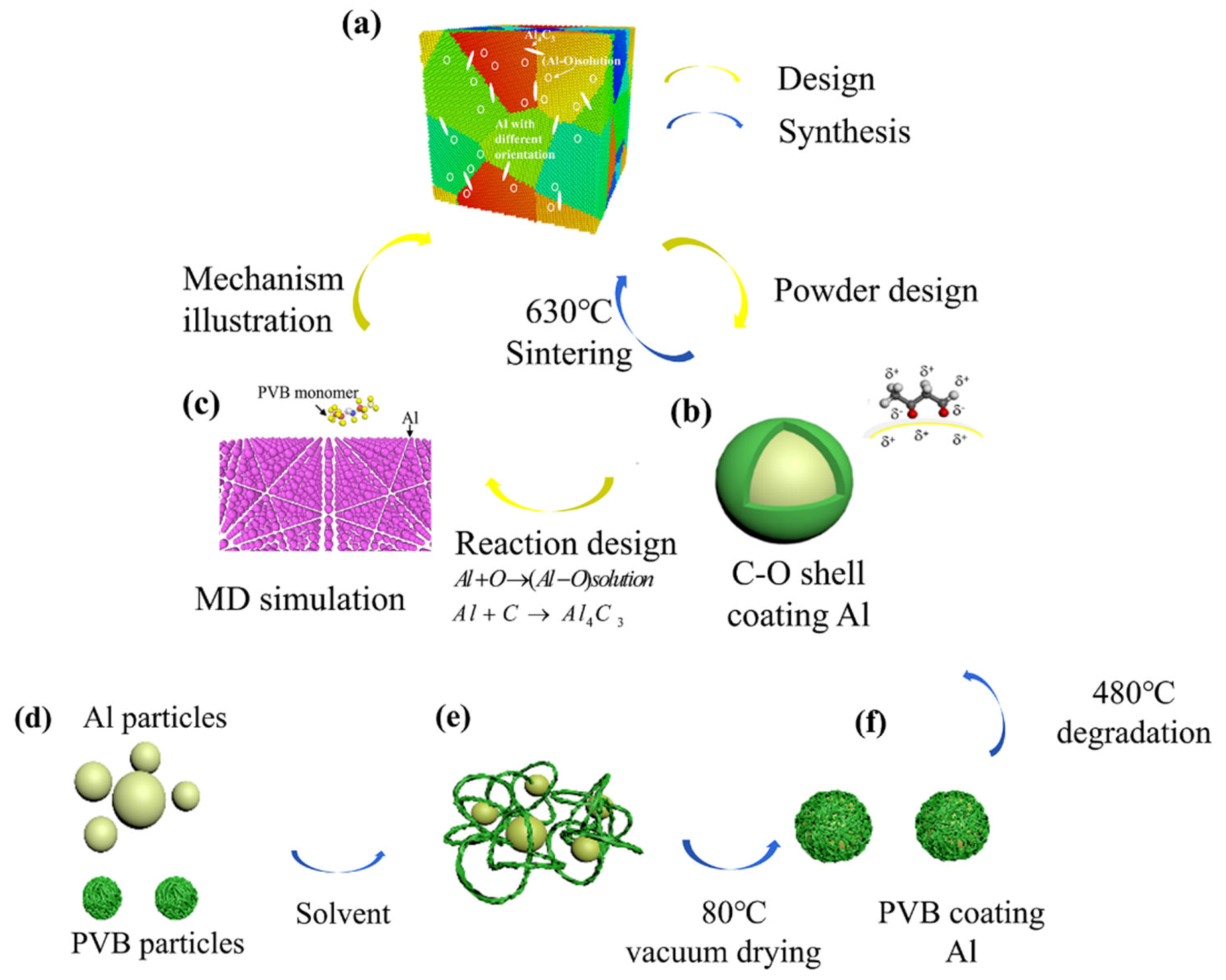
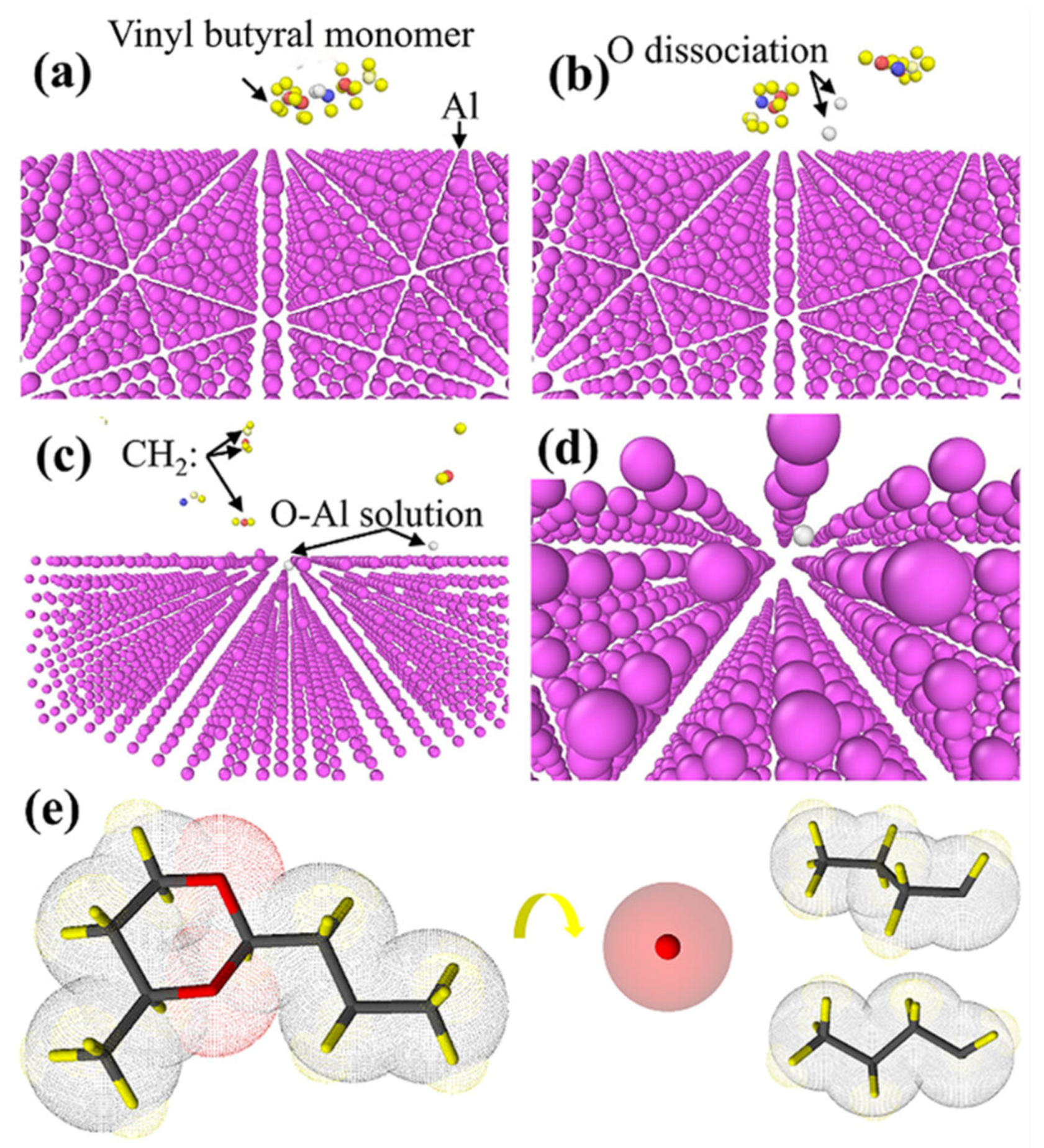
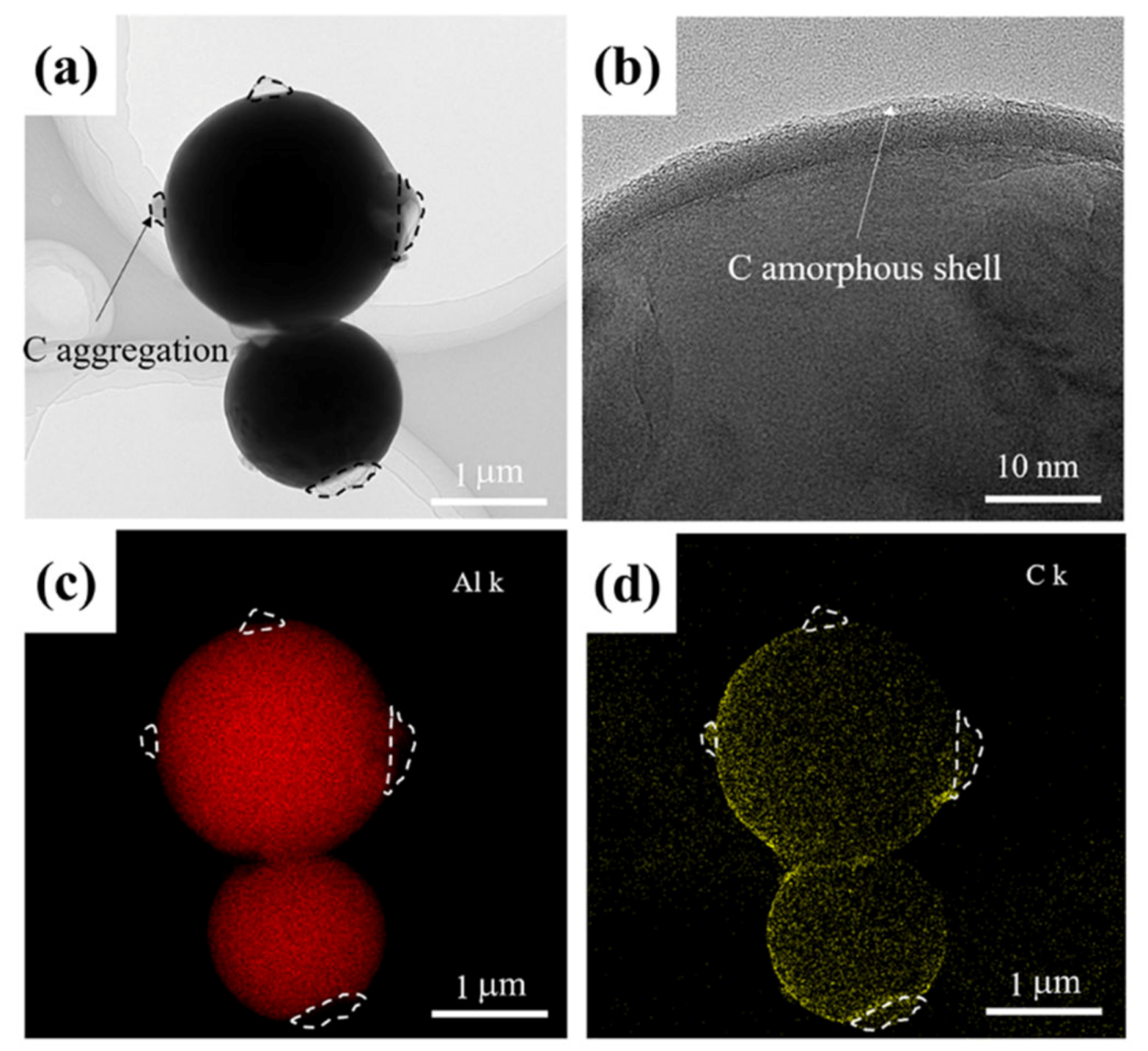
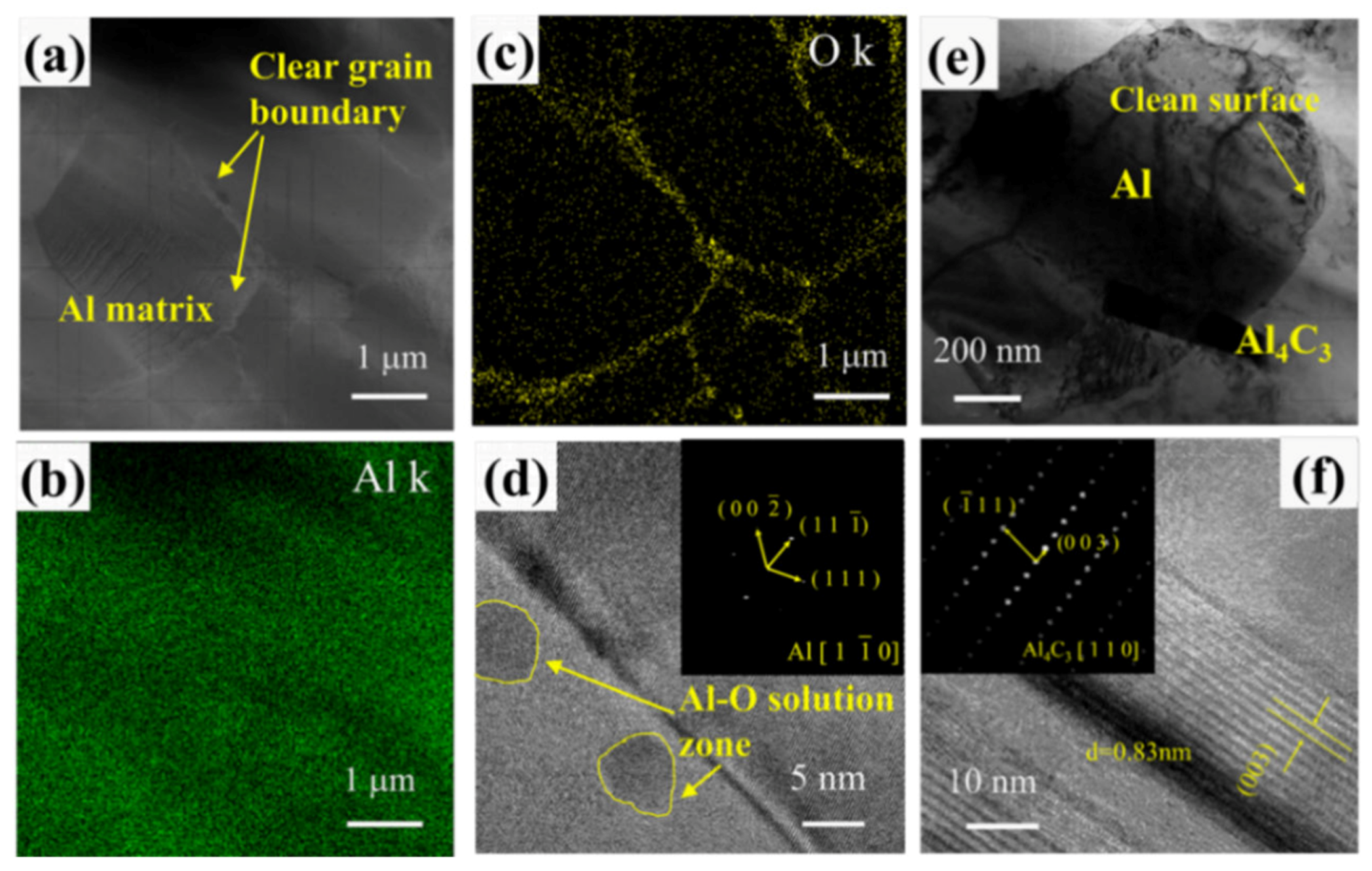
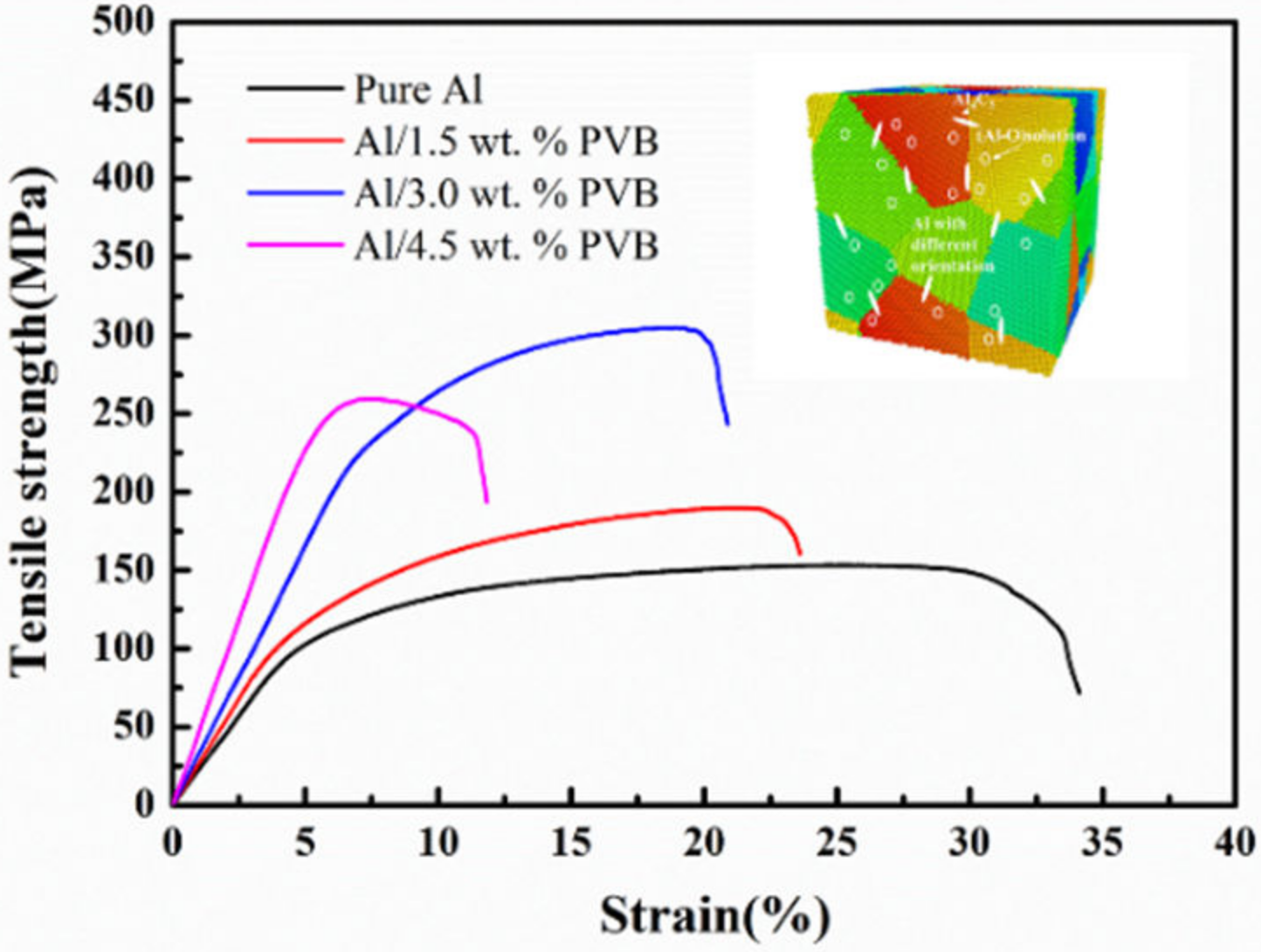
| Al Modified by PVB Content (wt.%) | Modified Powders | Bulk Composite (Calculation Result) | ||
|---|---|---|---|---|
| C Content (wt.%) | O Content (wt.%) | Al4C3 Content (wt.%) | Al-O Solution Content (wt.%) | |
| 1.50 | 0.513 | 0.019 | 1.538 | 0.032 |
| 3.00 | 1.036 | 0.041 | 3.107 | 0.069 |
| 4.50 | 1.631 | 0.063 | 4.892 | 0.106 |
© 2020 by the authors. Licensee MDPI, Basel, Switzerland. This article is an open access article distributed under the terms and conditions of the Creative Commons Attribution (CC BY) license (http://creativecommons.org/licenses/by/4.0/).
Share and Cite
Hu, J.; Zhang, J.; Luo, G.; Sun, Y.; Shen, Q.; Zhang, L. Design and Synthesis of C-O Grain Boundary Strengthening of Al Composites. Nanomaterials 2020, 10, 438. https://doi.org/10.3390/nano10030438
Hu J, Zhang J, Luo G, Sun Y, Shen Q, Zhang L. Design and Synthesis of C-O Grain Boundary Strengthening of Al Composites. Nanomaterials. 2020; 10(3):438. https://doi.org/10.3390/nano10030438
Chicago/Turabian StyleHu, Jianian, Jian Zhang, Guoqiang Luo, Yi Sun, Qiang Shen, and Lianmeng Zhang. 2020. "Design and Synthesis of C-O Grain Boundary Strengthening of Al Composites" Nanomaterials 10, no. 3: 438. https://doi.org/10.3390/nano10030438
APA StyleHu, J., Zhang, J., Luo, G., Sun, Y., Shen, Q., & Zhang, L. (2020). Design and Synthesis of C-O Grain Boundary Strengthening of Al Composites. Nanomaterials, 10(3), 438. https://doi.org/10.3390/nano10030438





